How to Stop Caffeine Jitters and Get Relief Fast
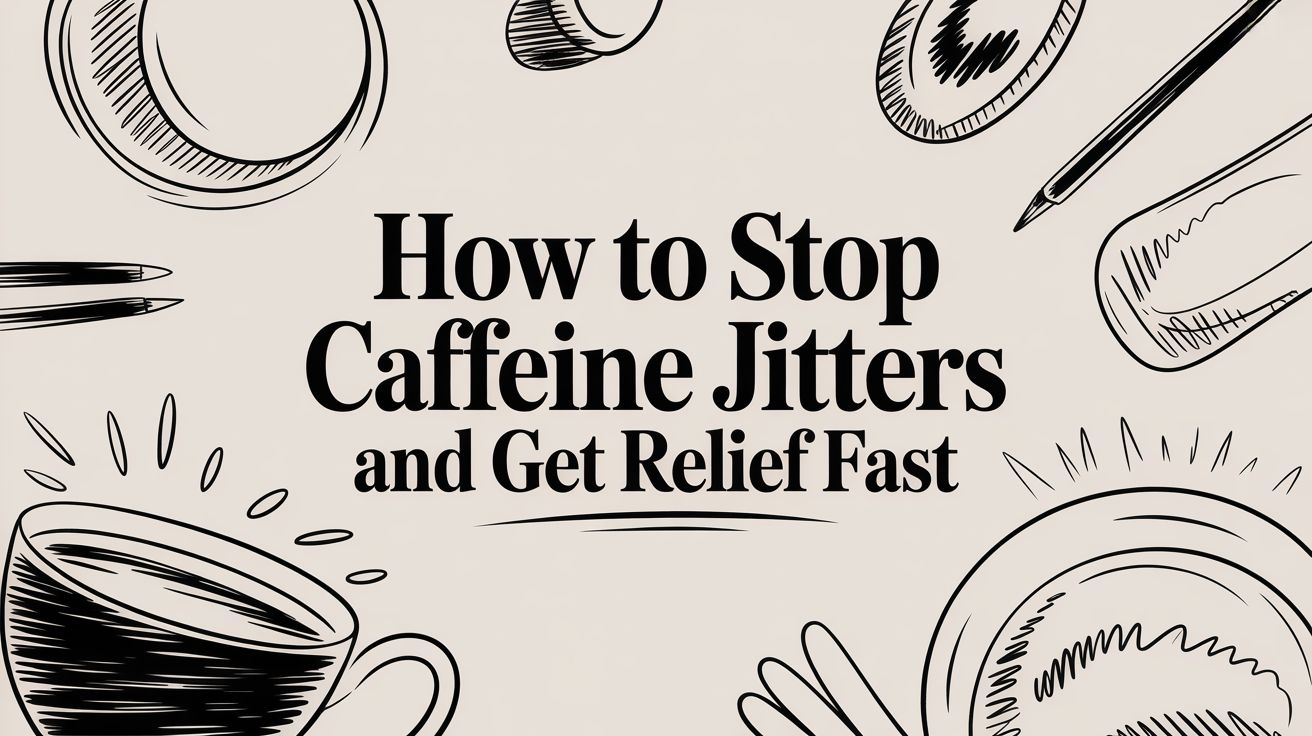
Before you can stop the caffeine jitters, you have to know what’s causing them in the first place.
At its core, caffeine is a powerful stimulant. It works by blocking your brain's natural "off" switch for alertness, which can quickly lead to overstimulation—that familiar shaky, heart-pounding, anxious feeling.
Why Your Morning Coffee Can Cause Jitters
That energetic lift you get from your morning coffee comes from its star ingredient: caffeine.
It works by hijacking receptors in your brain meant for a neurotransmitter called adenosine. Think of adenosine as your brain's natural brake pedal; it builds up throughout the day, making you feel sleepy and relaxed. Caffeine slides into adenosine's parking spot, preventing it from doing its job. The result? You feel wide awake and alert.
But that's only half the story. Caffeine also tells your body to release adrenaline, the classic "fight-or-flight" hormone. When you drink too much caffeine too fast, you flood your system with adrenaline, sending your central nervous system into overdrive. That sudden surge is what triggers the jitters.
This diagram shows exactly how caffeine molecules mimic adenosine, allowing them to block the receptors and stop you from feeling tired.
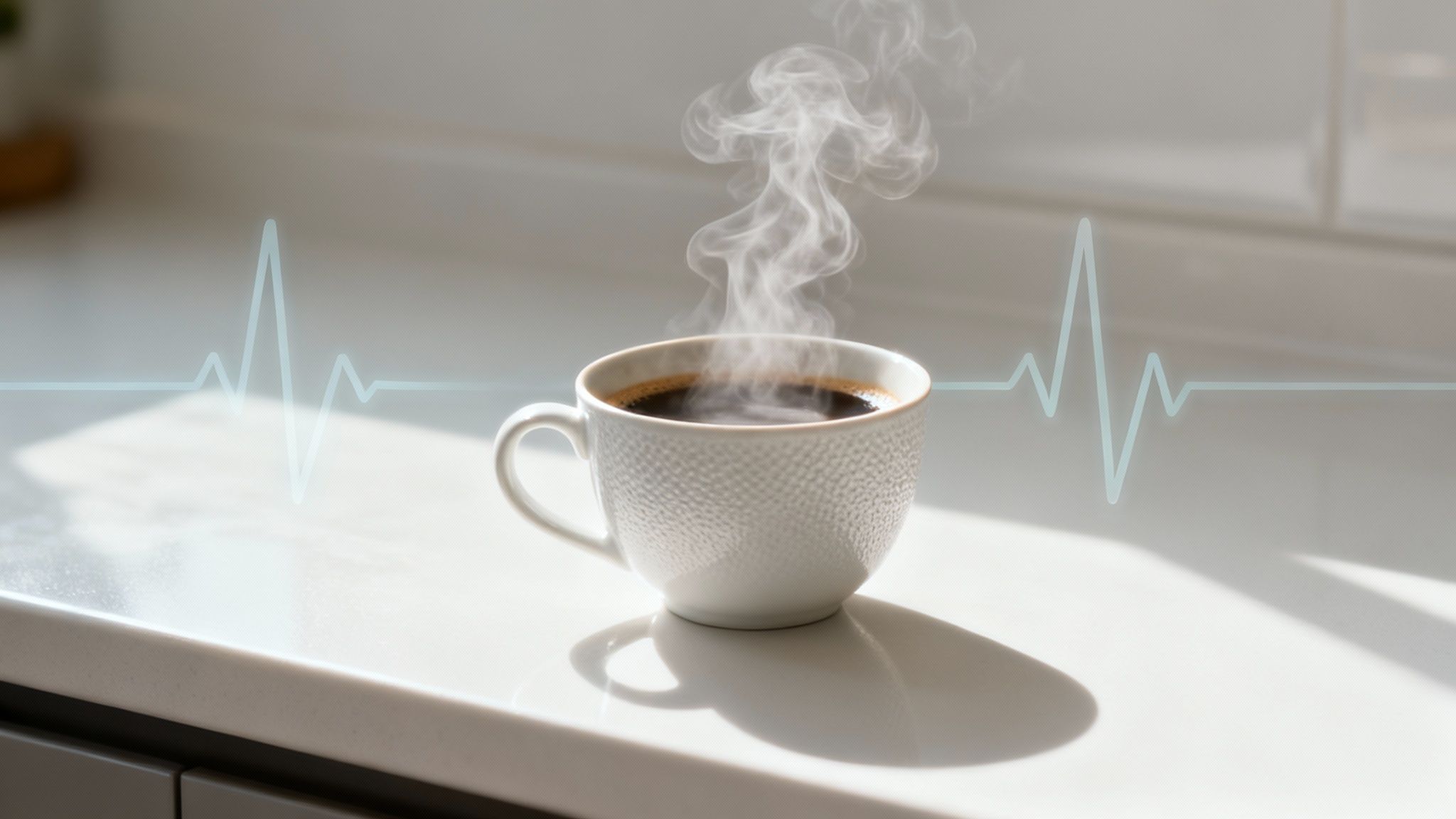
As you can see, their similar structures let caffeine act as a blocker, preventing your brain from hitting the brakes when it needs to.
Why You Feel Jittery and Others Don't
Ever wondered why you’re a shaky mess after one espresso while your coworker is happily downing their third? Your personal reaction to caffeine is unique, and it boils down to a few key factors:
- Genetics: Some people have gene variations that make their liver process caffeine much slower. If you’re one of them, you’re naturally more sensitive.
- Body Weight: A smaller person will feel the effects of the same amount of caffeine far more intensely than someone with a larger body mass.
- Tolerance: If you drink coffee every day, your body adapts. Over time, you’ll need more caffeine just to feel the same level of alertness.
If you’ve ever felt jittery, you're definitely not alone. A staggering 94% of adults in the United States drink caffeine regularly, meaning a huge number of people know exactly what those uncomfortable side effects feel like. You can dig into more caffeine consumption statistics to see just how widespread it is.
Once you understand that the jitters are just a sign of overstimulation, you can start making smarter choices to calm your system back down.
Immediate Relief for Caffeine Jitters
You know the feeling. The shaking hands, the racing thoughts, the sudden wave of anxiety after one cup too many. When you’ve overdone it on caffeine, you need a fix—and you need it now. Waiting it out isn't always an option, especially when you need to be calm and collected.
Thankfully, there are a few simple, science-backed ways to get your feet back on the ground and stop those caffeine jitters cold.
First thing’s first: stop drinking caffeine. It sounds obvious, but it’s easy to reach for another tea or soda without thinking, forgetting they’ll only make things worse. Put the mug down and focus on getting your system back to baseline.
Hydrate to Dilute and Flush
One of the best things you can do right away is grab a glass of water. Caffeine is a diuretic, which can leave you dehydrated and make symptoms like a racing heart feel even more intense.
Drinking water helps dilute the caffeine already in your system and helps your body flush it out faster. Start with one full glass immediately and keep sipping over the next hour. This simple act can make a huge difference in how you feel.
Move Your Body to Burn It Off
While you should probably skip the intense HIIT session, a bit of light movement is a fantastic way to burn off that frantic, nervous energy.
A brisk 15-minute walk can do wonders. Moving your body helps metabolize the caffeine faster and releases mood-boosting endorphins, which helps counteract the anxiety. It’s a productive way to channel that excess adrenaline flooding your system.
This infographic breaks down just how effective these quick fixes can be.
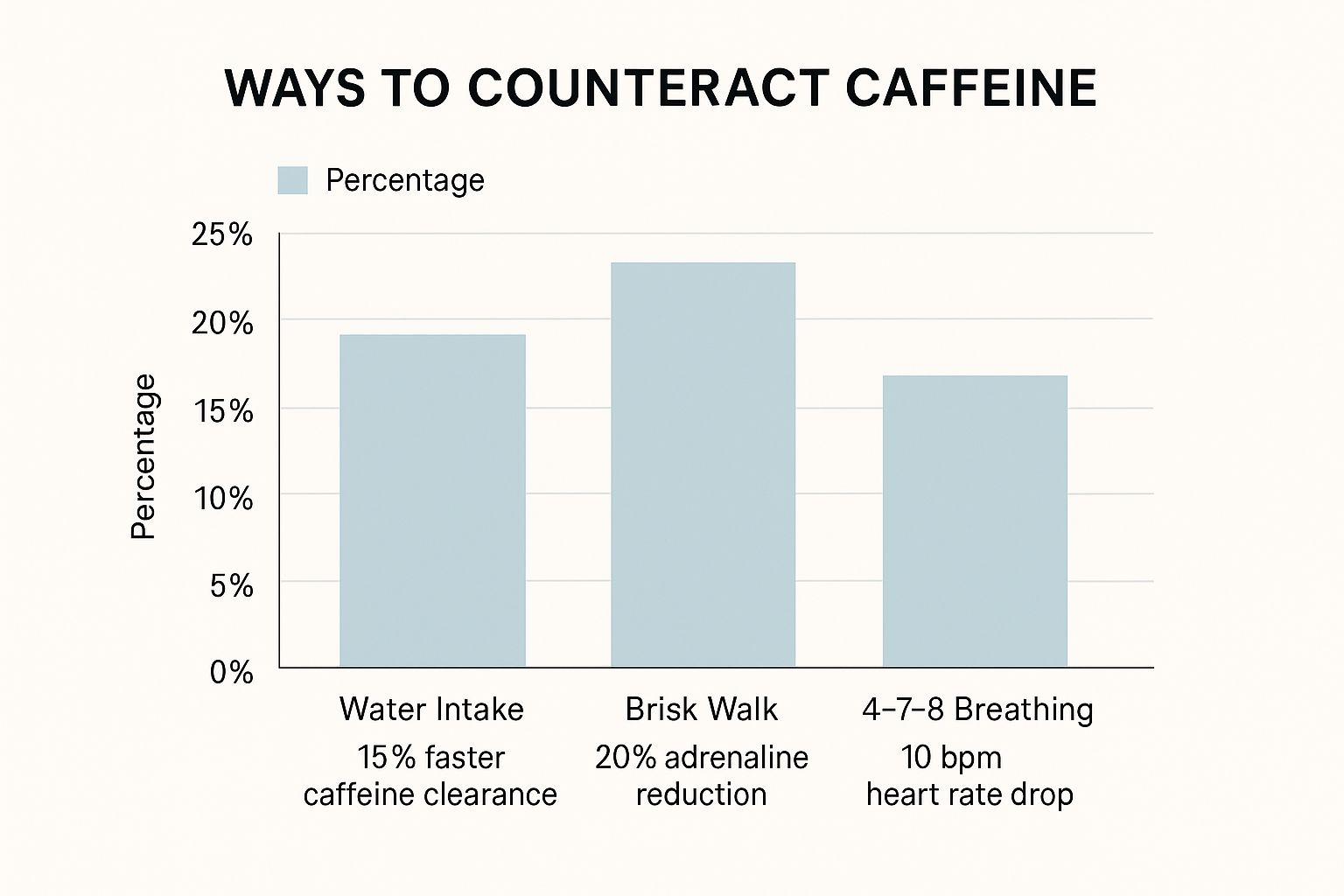
As you can see, taking immediate action helps your body process the caffeine while actively calming your nervous system down.
Calm Your Nervous System with Your Breath
Caffeine can kick your body into a "fight-or-flight" state, leading to shallow breathing and a pounding heart. The good news is you can manually hit the brakes on this response with a simple breathing exercise.
Try the 4-7-8 Breathing Technique: This is an incredibly powerful tool for calming your nervous system in just a few minutes.
- Inhale quietly through your nose for four seconds.
- Hold your breath for seven seconds.
- Exhale completely through your mouth for eight seconds.
Just repeat this cycle three to five times. This technique flips the switch to your parasympathetic nervous system—the one responsible for "rest and digest"—and sends a clear signal to your body that it's safe to relax. It’s a discreet and effective way to stop caffeine jitters whether you're at your desk or in a meeting.
Using Food to Counteract Caffeine Overload
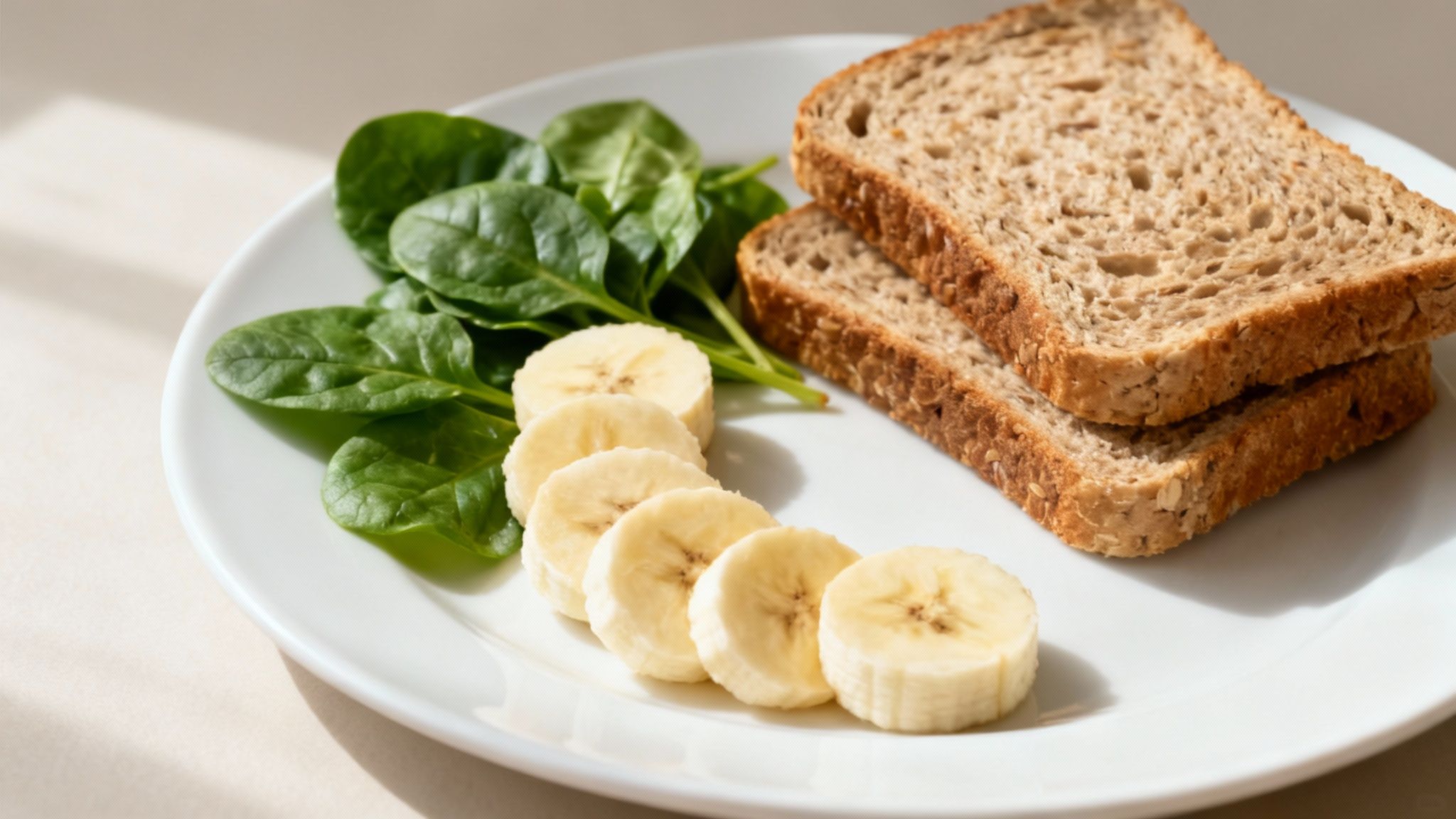
We’ve all been there: chugging coffee on an empty stomach to kickstart the day, only to end up with a racing heart and shaky hands. That’s because with nothing to slow it down, caffeine hits your system like a freight train, overwhelming your nerves.
A simple yet incredibly effective strategy is to never let your caffeine go solo. Pairing it with a balanced meal rich in protein, fiber, and healthy fats creates a natural time-release effect. The food slows down caffeine absorption, smoothing out the energy curve and preventing that jarring spike-and-crash cycle.
Think of it as adding a governor to an engine—you still get all the power, just delivered in a controlled, steady stream instead of a sudden, jerky burst.
Foods That Calm the Jitters
When you’re already in the throes of the jitters, the right foods can be a quick and effective lifeline. The goal is to grab something that supports your nervous system and stabilizes your blood sugar.
- Potassium-Rich Foods: Bananas are your best friend here. Caffeine can deplete your body's potassium, and topping up your levels helps manage symptoms like a racing heart and muscle twitches.
- Magnesium Powerhouses: Leafy greens like spinach, along with nuts and seeds, are packed with magnesium. This mineral is a champ at calming the nervous system.
- Complex Carbohydrates: A slice of whole-grain toast or a small bowl of oatmeal can work wonders. They help stabilize blood sugar, preventing the energy dips that make jitters feel so much worse.
What you choose to eat—or avoid—can make or break your experience with caffeine. Here’s a quick cheat sheet.
Foods That Help vs. Worsen Caffeine Jitters
| Food/Drink Category | Foods That Help (Calming Effect) | Foods to Avoid (Exacerbating Effect) |
|---|---|---|
| Fruits & Veggies | Bananas, avocados, spinach, kale | Fruit juices, sweetened fruit snacks |
| Carbohydrates | Whole-grain bread, oatmeal, brown rice | White bread, pastries, sugary cereals |
| Proteins & Fats | Nuts (almonds, walnuts), seeds (chia, flax), eggs | Processed meats, fried foods |
| Snacks & Sweets | Plain yogurt, dark chocolate (in moderation) | Candy, cookies, sugary energy bars |
| Beverages | Water, herbal tea (chamomile, lavender) | Soda, energy drinks, sweetened coffee drinks |
The takeaway is clear: whole, nutrient-dense foods are your ally, while sugary, processed items are the enemy when you're feeling overstimulated.
Your diet has a massive impact on your energy. The right nutrients can be the difference between feeling wired and feeling truly alert. That’s why some modern energy alternatives incorporate smoother stimulants like theobromine right from the start. You can learn more about as a smoother stimulant in our guide to see how it provides a more balanced boost.
On that note, sugary snacks and drinks are the absolute worst things you can reach for. They send your blood sugar on a rollercoaster, which only intensifies the shakiness and anxiety from too much caffeine. Always opt for a balanced, nutrient-dense snack instead.
Long-Term Strategies for Jitter-Free Energy
While knowing how to stop the jitters once they start is useful, the real goal is to prevent them from ever happening. The best way to do that is by building smarter, more sustainable habits around how you use caffeine. It’s about creating a healthier relationship with your daily energy boost so you get all the benefits without the shaky, anxious side effects.First things first: become a detective of your own consumption. For just one week, track every single source of caffeine you consume—coffee, tea, soda, chocolate, you name it. Jot down the time and how you feel afterward. You'll likely discover your personal "caffeine sweet spot," the exact amount that delivers clean focus without pushing you over the edge.
Adjust Your Timing and Routine
When you have your caffeine is just as important as how much you have. A common mistake is downing that first cup on a completely empty stomach. This allows the stimulant to hit your system all at once, creating a sharp spike that almost guarantees a jittery ride.
A simple fix? Always pair your morning coffee or tea with a meal that has some protein and fiber. This slows down caffeine absorption, leading to a much smoother, more gradual release of energy.
Also, try setting a "caffeine curfew" for yourself. Cutting off all caffeine by 2 PM can be a game-changer for your sleep quality, which in turn makes you less sensitive to its stimulating effects the next day.
Explore Smarter Alternatives
Not all caffeine sources are created equal. If coffee consistently leaves you feeling wired and anxious, it might be time to explore alternatives that offer a more balanced experience.
Green tea, for example, is a fantastic option. It naturally contains L-theanine, an amino acid famous for promoting a state of calm, focused alertness. L-theanine works with caffeine to smooth out its harsher edges, which is why so many people report a clean, steady energy from tea without the classic coffee jitters. This synergy is a perfect example of how combining the right ingredients can create a better outcome.
Many people are now turning to specialized supplements to achieve this balanced state intentionally. If you're looking for an alternative that bypasses traditional drinks altogether, you might be interested in learning about nootropic pouches, a better alternative to energy drinks. They are designed to deliver targeted focus without the crash.
By tracking your intake, optimizing your timing, and choosing smarter sources, you can build a routine that gives you sustained, jitter-free energy every single day.
Try Calming Supplements and Mindfulness Techniques
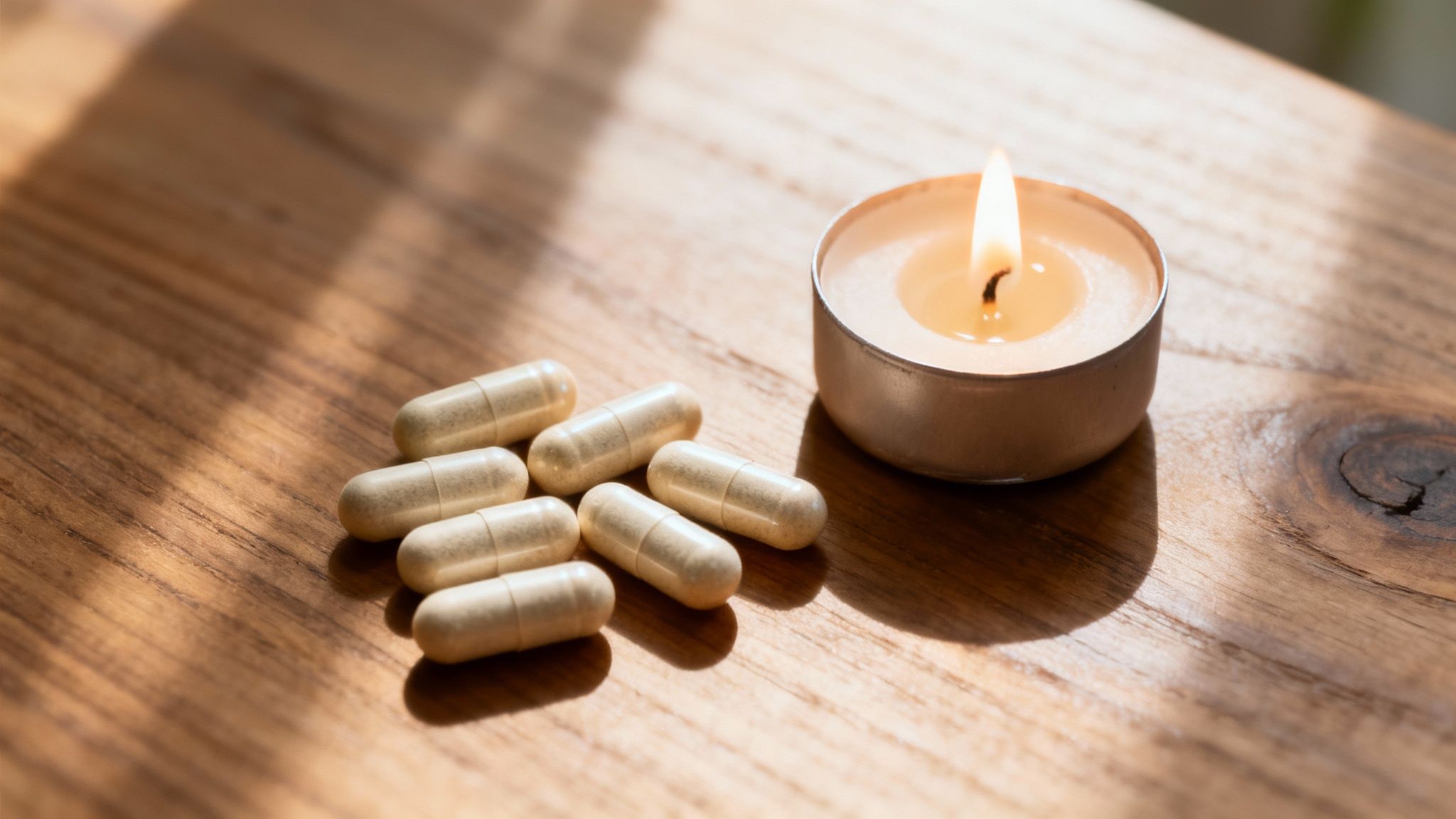
Sometimes, a glass of water and a snack just won't cut it, especially if you’re sensitive to caffeine. When you need to smooth out the rough edges of a caffeine rush, targeted supplements and a few simple mental tricks can make all the difference.
One of the best tools for this job is L-theanine, an amino acid found in green tea. Think of it as caffeine's perfect partner—it promotes a feeling of calm, focused alertness without making you drowsy. It takes the frantic "edge" off, quieting the mental chatter and physical shakiness so you can actually enjoy the focus.
If you want to go deeper into how these compounds create balanced energy, check out this guide on nootropics for students seeking better focus. It breaks down the science behind smarter cognitive support.
Mindfulness for a Quick Reset
Beyond supplements, you have a powerful tool that's always with you: your own mind. When caffeine has your thoughts racing a million miles a minute, mindfulness can pull you back to the present and stop that anxiety spiral in its tracks.
This isn't about sitting in silent meditation for an hour. These are quick, practical techniques you can do right at your desk.
- Mindful Breathing: Close your eyes and just notice your breath. Feel the air coming in and going out. Don't force it, just observe. This simple act tells your nervous system to chill out.
- Body Scan: Bring your attention to your feet. What do you feel? Warmth? Pressure? Slowly move your focus up your body—legs, torso, arms, head—just noticing the sensations without judging them.
This works by shifting your brain's attention away from those looping, anxious thoughts and grounding you in your physical body. It's an immediate way to regain a sense of control when you feel overstimulated.
Practicing these techniques regularly builds resilience. You're essentially training your brain to handle overstimulation better, giving you another reliable way to stay balanced and composed, even on a double-espresso day.
Your Questions About Caffeine Jitters, Answered
If you're trying to master your caffeine intake without feeling like a shaky mess, you're bound to have questions. Getting straight answers is the key to finding that sweet spot of clean energy. Let’s tackle some of the most common things people ask about caffeine jitters.
How Long Do Caffeine Jitters Usually Last?
The worst of it—that intense, shaky feeling—usually peaks within the first hour and can hang around for a few hours after that.
But here’s the thing: caffeine has a half-life of about 5 hours. That means half the dose is still floating around in your system long after the initial buzz wears off. This is exactly why that 3 PM coffee can still mess with your sleep at 10 PM.
To speed things up, grab some water, eat a real snack (not just sugar), and take a short walk. Moving your body and giving it fuel helps you metabolize the caffeine faster and takes the edge off the symptoms.
Can I Build a Tolerance to Avoid Jitters?
Yes, you absolutely can build a tolerance, which might make you feel less jittery from your usual amount. The problem? That tolerance often turns into dependence, where you suddenly need more caffeine just to feel normal. It's a losing game that only leads to bigger crashes and worse side effects down the line.
A much smarter move is to manage your intake from the start. If you notice you're needing an extra cup just to get going, it might be time for a "caffeine reset." Just slowly taper down your intake for a week or two, and you’ll bring your sensitivity back to a healthier baseline.
Does the Source of Caffeine Matter?
It matters—a lot. Where you get your caffeine from completely changes the experience.
- Coffee: This is your classic fast-and-furious option. It delivers a sharp, intense spike of energy that’s notorious for causing jitters and an equally sharp crash later.
- Tea: Green and black teas contain L-theanine, an amino acid that’s a total game-changer. It smooths out caffeine's rough edges, giving you a calm, focused alertness without the anxiety.
- Energy Drinks: These are often the worst offenders. They're typically loaded with massive doses of synthetic caffeine, sugar, and other stimulants that can easily overwhelm your nervous system.
Choosing a source with built-in buffers, like the L-theanine in tea, is one of the easiest ways to get clean, jitter-free focus.
Why Am I Suddenly More Sensitive to Caffeine?
Your caffeine sensitivity isn't a fixed trait; it can change day by day. Things like a bad night's sleep, high stress, hormonal changes, or even new medications can make you feel the effects much more strongly.
If your go-to cup of coffee suddenly has you feeling anxious and on edge, take it as a sign. Your body is telling you to look at the bigger picture—check in on your sleep, stress levels, and overall well-being.
Ready for a smarter way to focus? Dialed In Nootropics offers Focus Pouches designed for smooth, sustained energy without the crash or jitters. Experience mental clarity and calm concentration.
Article created using Outrank

